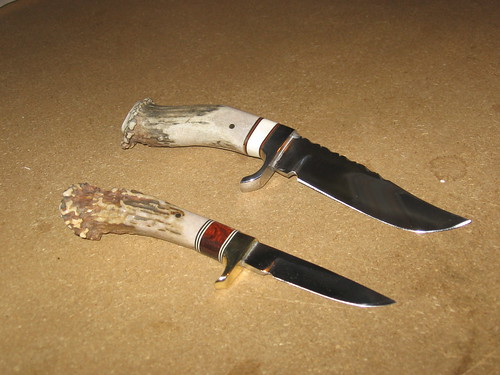

The initial bevel is cut in from the edge of the knife to the scribed line on the edge. This provides the maker the benefits of:
1 - The point at where the initial bevel stops (plunge) acts as a "edge stop" for the grinder. As you grind and go across the knife you can feel the point and it acts as a stop (Fair warning - it is pretty easy to run the grinder over the plunge, especially if you try and take too much material off in one pass)
2 - After you cut in the initial bevel, you are able to to see (as you look down) the grind match the edge you initially set
Step 4 - Intermediate Grinding

You continue grinding, "walking" your grind height to the point that you wish to stop (In this case we are going to go full height. You can see the benefit of the layout fluid provides if to want to stop short of going full height to ensure that your grind heights are equal on both sides.
Step 5 - Full Height Grind

Another continuation of the initial grind taken to full height. At this stage all of the work has been done to 60 grit. At this stage your grind should be pretty well set. Once you've reached this point you need to refine the scratches. This is done by using successivly finer belts. I usually go to something around 240-320 grit before heat treatment. To refine the scratch pattern, the typical progression is to double the grit (Grits are finer as the number increases) as you go. For this sequence it would go 60-120-240-320. Lately I've been using 3M Gators (Trizact CF) Bets.

IMO they are an awesome belt for refining scratches and minimal material removal, which matches my grinding style. In my case my belt progression goes 60 - A300 (Gator) - A160-A100-A65. This progression yeilds a nice consistent 280grit finish.
Well thats as far as I got last week. I'll pick up the tutotial from here when I get back into the shop. We still need to clean up the plunge, drill holes for the handle hardware and heat treat the knives










